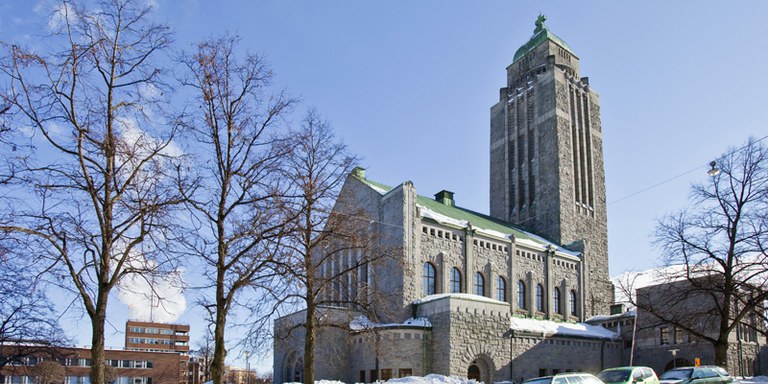Kallio church

The decision to divide the large parish of Helsinki into six parishes was made on May Day 1907. The 30,000 Helsinki residents living north of the Pitkäsilta bridge received a new church. The church was dedicated in 1912. The landmark of Kallio was designed by Lars Sonck, one of our best-known church architects.
The grey granite church ends the longest straight street axis in Helsinki, formed by Unioninkatu and Siltasaaren katu streets. The shape of the Kallio church is a rectangle, with two lower annexes. The pillars supporting the gallery divide the central part of the church into three aisles. The high tower of the church is placed to emphasise the choir, at the end of which is a semi-circular, pilastered extension covered by a semi dome.
Architect, Lars Sonck, is said to have taken the shape of the church from the dimensions of the Solomon's Temple, described in the Old Testament. The interior dimensions, on the other hand, are reminiscent of the Temple in Jerusalem. Longitudinally, the altar of the church is exactly in the same place as the screen in the Temple in Jerusalem between the Holy and the Holy of Holies.
The church is one of the purest representatives of the Romantic nationalism style in Finland. The church is decorated with Art Nouveau style murals. The leading motif is Christian floral symbols. The window and door bays have roses which join the cross and wreath motifs in the arches. A real rose garden is painted on the stairways leading to the galleries. Lilies encircle the arches. The palm branches of the altar vault symbolise the coming of Christ as the Prince of Peace. The grapevine branches in the side boxes depict the connection of the parish to Him. The symbol of victory, a laurel wreath and a rooster, reminding us of the vigil, and the symbol of the Holy Spirit, the dove, also recur as pictorial motifs.
The exterior of the church has remained as it was originally, but the interior has undergone major changes and renovations. The organ was originally in the gallery above the altar, and the pulpit was behind the altar. The pulpit was moved to its current place in 1924. The chandeliers only came to the church in 1932, and the organ was moved to the rear gallery in 1957.
The first renovation of the church took place in 1955–1956 in accordance with the proposals of interior designer, Antti Salmenlinna. He also designed the communion table and font. The semi-circular altar was changed to a rectangular one.
Ristiinnaulittu (Crucified) and the wooden relief, Tulkaa minun tyköni, kaikki työtätekevät ja raskautetut, niin minä annan teille levon (Come to Me, all who are weary and heavy-laden, and I will give you rest), sculpted by sculptor, Hannes Autere, are from 1956. The parents of the church verger at the time, a mason and a washerwoman, as well as the caretaker from next door and neighbourhood families with children are portrayed in the relief. The triumphal cross of the church choir was set in place at the same time as the altarpiece. Over a thousand gilded pearls form the pearl gate by the altar.
The communion cloth by Lina Palmgren from 1912 portrays a pelican feeding her young with her blood, a symbol of Christ's suffering love and communion. The church has a stoledesigned by Ilmari Wirkkala. The skilful silversmith, Eric O. W. Ehrström, made the communion requisites of the church, combining the influence of art nouveau and classicism.
The original colouring of the church was recovered in the renovation of 1986–1987. The side offices of the church were renovated for meetings and the church register office was moved to the parish building. The altar was made of stone, matching the nature of the district and the church.
Acoustically superior, the Kallio church is one of the most significant concert churches in Finland. The first church organ was located in the gallery above the altar. The current, French romantic musical instrument in the rear gallery was built by Swedish organ builder, Åkerman & Lund, in 1995. The baroque style choir organ from 1987 is from the Kangasala organ builders. It was designed by organist, Pentti Pelto.
An urn vault was built under the Kallio church in 1990. This continues the old Christian tradition of building under the church, which was discontinued with the emergence of the practice of using cemeteries in the 18th century. In addition to places for 3,000 urns, the vault also has a rock tomb, where ashes can be placed after or instead of urn storage. The sanctity of the grave is adhered to in the vault. Relatives can only visit when the urn is laid to rest. The altarpiece of the urn vault is a glass work by artist, Jaakko Somersalo: Ylösnousemus (Resurrection), from 1958.
The departed buried in the church can still be remembered at the altar under the gallery. A memorial plaque for all those buried in the church is situated on the wall of the church, and people can place flowers under it or light a candle.
The seven German bells in the granite tower play a tune by Jean Sibelius at noon and six o'clock pm. Yleisradio, the national broadcasting company, used the tune for decades for its evening bells on Saturdays.
During the Second World War, one of the air surveillance points of Helsinki was in the tower of the Kallio church. Until the 1970s, the same tower served as the reference point for land surveying in the city.
Celebrations at the church
Members of the church can organise a baptism, a wedding or a funeral free of charge in the church.
The Kallio church seats 1,100 and the two parish meeting halls, Kappelisali (Chapel hall) and Vihreä sali (Green hall) seat 50 and 30, respectively. There are also parish meeting halls at Siltasaarenkatu 28. Access for people with reduced mobility can be organised from the side of Suonionkatu, when requested in advance.






